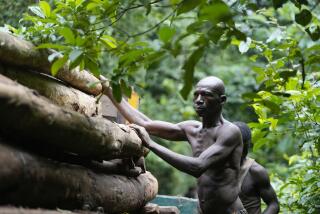Ghana Takes to Treetops to Save Forest
- Share via
KAKUM NATIONAL PARK, Ghana — The tourist stands frozen halfway across the rope bridge between mammoth trees, swaying more than 100 feet above the floor of the lush forest.
“Oooh, this is the scariest part of all,” said Mansa Orraca-Tetteh, a 36-year-old native of Ghana who now lives in Virginia. “I’ve seen enough trees to last me a lifetime.”
By the end of her lifetime, the tropical trees and wild animals of West Africa’s rain forests may no longer be in sight.
The Upper Guinean Forest that covers parts of Ghana, Ivory Coast, Liberia, Sierra Leone and Guinea has shrunk to only a fifth its former size.
“These places are just becoming little fragments in a sea of land completely altered by humans,” said John Oates, a zoologist and anthropology professor at City University of New York who studied primates at Kakum National Park, one of those fragments. “If we’re not careful, Kakum would be the only place left with any protection.”
Kakum is a 145-square-mile sanctuary in the southwestern corner of Ghana, where forest elephants, monkeys and elusive bongo antelopes roam among more than 800 species of birds and butterflies, reptiles and amphibians. What may save it is tourism.
With a $2-million grant from the U.S. Agency for International Development and assistance from private American conservation and tourism groups, Ghana has turned the forest into a tourist attraction just 18 miles from its impoverished seaside cities.
If successful, it will be a remarkable achievement for West Africa, which has never been able to compete with the big-game reserves of eastern and southern Africa.
War, poverty and lack of education have destroyed much of the once-lush environment of West Africa. The cutting of timber, a crucial foreign currency earner in the region, has led to the ruin of forests. Years of civil war in Liberia and Sierra Leone have decimated animal populations.
Ivory Coast, named for its once-flourishing elephant population, can barely support a game park. A joint venture with South Africans failed after the investors, angry over what they viewed as disinterest from the Ivorian government, pulled out and left the antelopes they had imported to be killed by poachers.
“West African wildlife is seen with a very utilitarian perspective--everything is eaten and the poaching pressures are enormous,” said Mari Omland of Conservation International, a Washington-based group providing technical support to the Ghanaian government.
Omland believes Kakum can become a major tourism site that protects the environment while providing jobs in one of Ghana’s poorest regions.
“I believe West Africa is really sort of the new opportunity in Africa for wildlife viewing,” she said in a telephone interview. “Kenya is still a very spectacular experience to be able to do wildlife safaris there . . . but the place is really overrun by tourists.”
Kakum opened last year, and in April it inaugurated the only treetop walkway through an African rain forest--a vertigo-inducing, swinging bridge that winds through the trees at heights reaching 140 feet. Park officials hope for 21,000 visitors by year’s end and revenue of $40,500 from admission fees--about $3 for foreigners and 50 cents for Ghanaians.
But the economic benefits go far beyond that. The nearby Cape Coast area, known for its historic slave castles and dramatic scenery, is hoping increased tourism and new hotels will translate to $5.7 million in annual revenue and create hundreds of jobs.
Visitors can spend days in the park before spotting the timid forest animals, one reason the developers added the tree walkway.
“We needed to have realistic expectations. We knew we wanted to have something other than the wildlife that people would demand,” said Chuck Hutchinson, technical adviser in Kakum for the Midwest Universities Consortium for International Activities. “Even if people don’t see animals, they’re happy that they’ve come.”
They may glimpse a pack of elephants hiding amid the tropical trees or spot the skittish bongo antelope with zebra-like stripes. Sadly, Oates said, he found no trace of the endangered red colobus monkey and white-collared mangabey found only in western Ghana and neighboring Ivory Coast.
Kwame Aduyaw Sasah, one of Kakum’s guides, hopes that by explaining the value of the forest he grew up around, he can help save it.
“South Africa is all about big game and hunting,” said Kwame. “Here, it’s all equatorial. It’s all about getting people to respect and understand our environment.”
More to Read
Sign up for Essential California
The most important California stories and recommendations in your inbox every morning.
You may occasionally receive promotional content from the Los Angeles Times.













